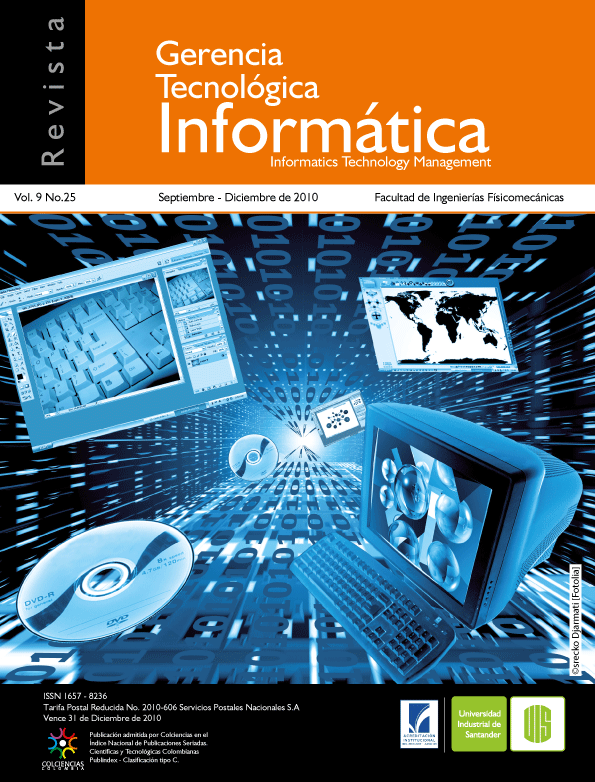VALIDACIÓN DEL MODELO LIVIANO DE GESTIÓN DE REQUISITOS PARA PEQUEÑAS EMPRESAS DE DESARROLLO DE SOFTWARE
How to Cite
Abstract
RESUMEN ANALÍTICO
Actualmente las pequeñas empresas de desarrollo de software están abordando uno de sus mayores retos: constituirse en industria; es decir, pasar de desarrollos puntuales y muchas veces artesanales a industrializar toda su producción de software y para ello requieren del conocimiento y aplicación de los modelos y metodologías de calidad que tiene esta industria. Estas empresas, conformadas hasta por nueve personas, no logran aplicar estos modelos pues su gran obstáculo se observa en los altos costos, los prolongados tiempos de implementación y el gran esfuerzo humano.
El Laboratorio de Investigación para el Desarrollo de la Ingeniería de Software (LIDIS), siendo con-secuente con esta situación, adelantó una investigación con el objetivo de proponer y validar un modelo liviano de gestión de requisitos apropiado al contexto de las pequeñas empresas que, basado en los estándares internacionales, les permitiera la aplicación de buenas prácticas a sus procesos de desarrollo de software.
El modelo fue validado en nueve proyectos de tres empresas desarrolladoras de software.
El artículo presenta inicialmente la caracterización de las empresas pequeñas de software, luego muestra el modelo propuesto y posteriormente el diseño experimental con sus respectivos resultados que confirman la validez del modelo.
PALABRAS CLAVES: Gestión de requisitos, Proyectos de desarrollo de software, Empresas de software.
ANALYTICAL SUMMARY
ICurrently small software development companies are addressing one of its greatest challenges: industry become, that is, moving from specific developments and often craft to industrialize their entire production of software and therefore require knowledge and application of models and quality methodologies this industry has. These companies made up to nine people, fail to implement these models as their major obstacle is observed in the high costs, long implementation times and the great human endeavor.
The Research Laboratory for the Development of Software Engineering (LIDIS), being consistent with this situation, advanced research with the aim to propose and validate a lightweight requirement management model appropriate to the context of small businesses, based on international standards, allowed the application of good practices to their software development processes.
The model was validated in nine projects in three software development companies.
The article initially presents the characterization of small business software, then shows the proposed model and then design their own experimental results confirming the validity of the model.
Downloads
References
- SEI Capability Maturity® Integration (CMMi),Version 1.1., CMMi for Software Engineering(CMMi-SW, V1.1) Continuous Representation,CMU/SEI-2002-TR-028, Software EngineeringInstitute, Pittsburgh, 2002.
- ISO/IEC 15504:2003-06, Information Technology– Software Process Assessment (parts 1-9),International Organization for Standardization.
- PINO, Francisco. GARCIA, Félix. PLATINI, Mario.Revisión sistemática de procesos de software enmicros, pequeñas y medianas empresas. Revistaespañola de innovación, calidad e ingeniería desoftware. Vol 2 No. 1. 2006. pp. 6-23.
- ACUÑA, Sivia. FERRE, Xavier. LÓPEZ, Marta yMATE, Luis. The Software Process: Modeling,Evaluation and Improvement. Handbook ofSoftware Engineering and Knowledge Engineering.World Scientific Publishing Company, Argentina,2000.
- RCCS. Red Colombiana de Calidad de Software.(Colombia), (cited 20 may.,2010). http://rccs.cidlisuis.org/index.php?option=com_content&task=view&id=12&Itemid=20
- ANACLETO, Alessandra. GRESSE VONWANGENHEIM, Christiane. SALVIANO, Clenio andSAVI, Rafael. A method for process assessmentin small software companies. En: InternationalSPICE Conference on process assessment andimprovement. (4th: 2004: Portugal).
- PETTERSSON, Frederik. IVARSSON, Martin.GORSCHEK, Tony and OHMAN, Peter. Apractitioner´s guide to light weight softwareprocess assessment and improvement planning.The Journal of Systems and Software. Volume 81 ,Issue 6. 2008. pp. 972-995
- GRESSE VON WANGENHEIM, Christiane. WEBER,Sergio. HAUK, Jean and TRENTIN, Gisele.Experiences on establishing software processesin small companies. Information and softwaretechnology. Volume 48 , Issue 9. 2006. pp. 890-900.
- HABRA, Naji. ALEXANDRE, Simon.DESHARNAIS, Jean-Marc. LAPORTE, Claude.And RENAULT, Alain. Initiating softwareprocess improvement in very small enterprises:Experience with a light assessment tool.Information and Software Technology, Volume 50,Issues 7-8. 2008. pp 763-771
- MAS, Antonia. y AMENZUEL, Esperanza. Modelo demejora de procesos aplicados a Pymes. En revistaEspañola de Innovación, Calidad e Ingeniería deSoftware, Vol 1, No 2, p. 7-29. Madrid: España,2005.
- MERCHÁN, Luis., y URREA, Alba, REBOLLAR,Rubén. Definición de una metodología ágil deingeniería de requerimientos para empresasemergentes de desarrollo de software del suroccidente colombiano. En Revista Guillermo deOckham, Vol. 6, No 1, p. 37-50. Cali: Universidadde San Buenaventura, 2008.
- LAPORTE, Claude. APRIL, Alain y RENAULT, Alain.Applying ISO/IEC software engineering standardsin small settings: historical perspectives and initialachievements. En: SPICE Conference on ProcessAssessment and Improvement. (6th:2006:Luxembourg).
- LAPORTE, Claude. The Application of InternationalSoftware Engineering Standards in Very SmallEnterprises. En: ENCUENTRO DE CALIDAD DESOFTWARE. (2006: Cartagena)
- MERCHÁN, Luis y URREA, Alba. Caracterizaciónde las empresas pertenecientes a la industriaemergente de software del sur occidentecolombiano Caso red de parques PARQUESOFT.En: CONGRESO COLOMBIANO DE COMPUTACIÓN.(2do:2007: Bogotá)
- JURISTO, Natalia y MORENO, Ana. Basics ofsoftware Engineering Experimentation. Boston:Kluwer Academic Publisher, 2001. 395p.
